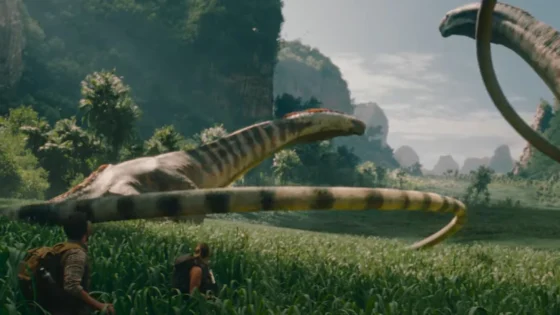The Legacy of Steven Spielberg’s Jaws
Richard Dreyfuss, Roy Scheider, and Robert Shaw star in this terrifying thriller about an enormous man-eating Great White Shark that terrorizes the fictional coastal summer resort town of Amity, Long Island on the Fourth of July weekend. Based on the trashy best-selling novel by Peter Benchley (who also provides the screenplay along with Carl Gottlieb), this somewhat low-budget Hollywood film (operating on a reported $12 million) had a mostly no-name cast, and was a surprise cash cow. Thanks to a sophisticated, unrelenting publicity campaign, Jaws was the first film to rake in over $100 million (it grossed more than $260 million at the domestic box office and nearly $475 million worldwide). It went on to spawn three sequels (all terrible), laid out a blueprint for summer blockbusters, and put Steven Spielberg onto the A-list of Hollywood directors.
Spielberg doesn’t serve up mass quantities of blood and gore but what makes Jaws work is the confident direction combined with stellar editing that draws the audience into relaxing at precisely all the wrong moments. Spielberg’s meticulous attention to creating suspense recalls the best of Hitchcock. Jaws remains tense by not showing audiences the shark for the majority of the film. For the first hour, the only glimpses we catch of the beast are fleeting and indistinct. The camera doesn’t dwell on it until the final act. We are only treated to a long hard look at the shark when it passes by the deck of the ship, setting up the film’s most memorable line, “We’re going to need a bigger boat.” In the final scenes, it becomes apparent why Jaws gets so little screen time – it simply looks fake. Spielberg openly admits that if the technology had been better, he would have shown the shark more often. Ironically, it is this handicap that resulted in the film’s greatest strength. By keeping Jaws hidden from the audience, the movie effectively builds suspense and the end result is an edge-of-your-seat thriller.

The sheer ambition of making a movie on the scale of Jaws is admirable enough. Special effects at the time meant animation, blue screen model work, and crude animatronics so creating a convincing 26-foot great white shark seemed like an impossible task. The shark in Jaws was actually a combination of real footage and five different mechanical sharks (all nicknamed “Bruce” by the crew) built to be shot from different angles. Spielberg envisioned Jaws as a water-based reworking of his previous film Duel, and as he has stated in recent interviews, he was “young and fearless – or perhaps dumb.” Jaws flirted with disaster on land and water and the making of Jaws proved to be just as entertaining as the film itself. Each mechanical shark was made largely of plastic, weighed 1½ tons, and cost about $150,000. Although built for different purposes—one for left-to-right movements, another for right-to-left movements; a third for underwater scenes—each was similarly operated by hydraulic pistons and compressed air. Bruce required 20 assistants and a twelve-ton steel platform, to which the mechanical shark was attached by a 100-ft.-long umbilical cable, to be sunk to the ocean floor. The controls on the platform were operated by 13 technicians wearing scuba equipment. In short, it was a difficult feat and upon its debut, “Bruce” sank to the bottom of the ocean taking with it, half the budget of the film. In the special features Spielberg went on to say, “With all the planning we did, nobody thought much about the currents or anything at all about the waves.” A strong current would cause equipment boats to drift away. The watercolor would change, and the rhythm of the waves would fluctuate. “I could have just shot the movie in the tank.” The problems seemed endless yet decades later Jaws still remains Spielberg’s best film.

While you can’t deny the brilliance behind Spielberg’s direction, Jaws was a success due to a talented, relentless, and ambitious crew. The screenwriters deliver well-drawn characters, and crisp dialogue and wisely opted to introduce two villains; the face of bureaucracy and the man-eating beast. Cinematographer Bill Butler did remarkable work shooting much of the film from right above the waterline. The point of view of someone treading water helped increase the level of suspense – while on the Orca – he opted to use the wide expanse of sea and sky as an imposing background – emphasizing the isolation of the crew.

The film’s framing techniques are brilliant, most noteworthy is the steady-cam view looking down a 100-foot pole upon a rocking boat. Of course, no one can forget the main theme, for Jaws. The classic two-note shark theme is one of the most recognizable cues in movie music history. Combined with the shark’s p.o.v. camera shots, Williams’ music is enough to evoke the approach of the creature, even when we don’t see it. John Williams’ unforgettable Jaws theme reminds us of the terror that lurks just beneath the surface; its heartbeat-like pulsing tone of impending terror is more responsible for the power of the film than the shark itself. Finally, editor Verna Fields in her final editing assignment before her death in 1982, helped create an incredible sense of pacing, tension, and horror that made Jaws such a grabber. To this day many of the crew and cast members go so far as to say that it was her editing that saved the production.
“Jaws was more than a blockbuster.”
The acting, while a secondary element of the film, certainly doesn’t hurt. Spielberg builds the characters beyond the usual stereotypes so often found in Hollywood films. Roy Scheider is strong as the transplanted city cop trying to overcome his fear of the water. Richard Dreyfuss is surprisingly and effectively low-key as the scientific egghead and Robert Shaw (as Captain Ahab) is most outstanding. Bordering on parody, Shaw plays Quint as an old grumpy loner, slightly deranged yet slightly heroic. None of them had the box office draw of a Robert Redford or Paul Newman, but they all worked well as a team delivering breakthrough performances in some of cinema’s most unforgettable moments.

Spielberg overcame many obstacles and delivered one of the greatest primal scare-thrillers ever to come out of Hollywood while taking in four Academy Award nominations and winning three (Best Sound, Best Original Score, and Best Film Editing). Jaws was chosen by the prestigious American Film Institute as one of the 100 Greatest American Films of all time and forever changed the way entire generations thought about swimming in the ocean. Jaws was more than a blockbuster; it remains a cultural phenomenon and one which sparked a worldwide fascination with sharks.
– Ricky D




































Patrick Murphy
January 5, 2017 at 1:29 am
I’ve seen ‘Jaws’ at least 100 times. It’s the movie that made me want to make movies, as pure a piece of filmmaking prowess in all areas as exists. I can’t imagine how it would have turned out if that shark didn’t break down, though, and I don’t want to. The sequels may have largely ruined its reputation among casual audiences, but ‘Jaws’ is right up there with ‘Psycho’ for cultural horror phenomenons. I’ll never put on a life jacket again.
Ricky D Fernandes
January 5, 2017 at 5:03 am
I completely agree. Have you ever seen the making of documentary? It was featured in the double DVD disk set they released years ago. It is AMAZING and well worth watching. Just watching the camera man balance himself on a 100-foot pole so he could get a bird’s eye view is astounding.
Patrick
January 5, 2017 at 6:56 pm
Absolutely, I bought that special edition as soon as it released and promptly absorbed everything on it, doc, trivia, and all. One of the best behind-the-scenes features I’ve seen, the kind that makes DVDs special and still worth collecting. The making of ‘Jaws’ is endlessly fascinating, and I’m glad you brought up Verna Fields in the article. Like Paul Hirsch, Richard Chew, and Marcia Lucas on Star Wars, she doesn’t get enough credit for making a now classic movie as great as it is.
Bill Mesce
July 5, 2022 at 3:28 pm
Look, it’s a classic, and that it was so brilliantly realized by such a young filmmaker is all the more impressive. But a slight correction: you said the $12 million budget made it a low budget production. Not in its time. It was considered a “runaway” production because the shoot went way over budget. The original budget was $4 million (about $22 million in today’s dollars accounting for inflation but not non-inflation-related increases in cost). That $12 million would’ve been about $66 million today, which is around the average cost today excluding marketing. For perspective: THE FRENCH CONNECTION, made in 1971, cost $2 million, Star Wars, made 1977 and with a lot more effects, was done for $11 million. For its day, JAWS was pricey. But I did really enjoy this piece; I waited in line for an hour to see it back in The Day.